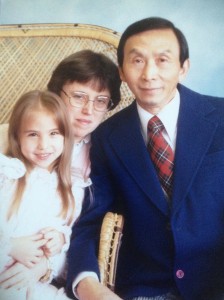The Biracial Messiah
 When I was a baby, I babbled in tones. Chinese tones.
When I was a baby, I babbled in tones. Chinese tones.
My mom was a white Missouri farm girl who became a Methodist missionary. She spent 14 years in Taiwan, where she met my dad, a Chinese mainlander in exile on the island since 1949. There, they created me, the intoning babbler. Immersed in the sounds of Mandarin and Taiwanese for the first 20 months of life, when my family moved to small-town Missouri in 1984, my day-care workers understandably couldn’t tell the difference between intoned baby babble and sophisticated Mandarin political discourse. They assumed I was very gifted — fluent in Chinese. But Mom claims that when I heard them saying that I spoke Chinese, I used to insist, “I’m not Chinese! I’m English!”
So began my awkward struggle to come to terms with my blurred identity in this starkly black, white, yellow, red, and brown world. It was a struggle that would continue into adolescence, when my white friends would make squinty eyes at me to remind me that I wasn’t really one of them, when heads turned every time my family walked into a restaurant, when I played “eeny-meeny-miny-moe” to pick my ethnicity on the SAT’s, and when I happily discovered Chinese peers in college, only to find that I wasn’t really one of them either.
This month, we enter into Asian American Heritage Month, and—as I look around my church for the Asian folks—I see that many of us are biracial. I haven’t been around so many people who share mixed heritage since my honeymoon in Hawaii! I love it!
As an adult, I have come to accept that we biracials just don’t fit comfortably into any categories. We are, by our family make-up and confusing features, inherently awkward and indefinable. We are born of strange stories and unconventional encounters. Some of us are the babies of war, rape, and sexual exploitation. Others of us have been conceived out of boundary-crossing passion and intentionally anti-racist relationships. And we biracials all hold within our bodies, entwined in our DNA, both oppressor and oppressed, two cultures and peoples who, at times, have fought and killed one another, shamed and abandoned one another. The tension of these peoples continues to ferment in our bodies and spirits, as we struggle to reconcile mother with father, dark eyes with light hair, individualism with family loyalty, geraniums with orchids.
The reconciliation between the two can get very complicated. But it is a reconciliation that is worth the complication. In fact, I have come to believe that our world has a lot to learn from us biracials. In such a stained world, where bitterness, blame, and benightedness make us wary of each other, the most difficult and revolutionary thing we can do is courageously come together to create something new.
There is a passage in Scripture that I call the “Biracial Messiah” passage. It reads:
…now in Christ Jesus you who once were far off have been brought near by the blood of Christ. For he is our peace; in his flesh he has made [Jews and Gentiles] into one and has broken down the dividing wall, that is, the hostility between us. He has abolished the law with its commandments and ordinances, that he might create in himself one new humanity in place of the two, thus making peace, and might reconcile both groups to God in one body through the cross, thus putting to death that hostility through it.
Ephesians 2:13-16
In the New Testament, the fleshly Body of Christ becomes a metaphor for the church, and the early church was indeed a rocky marriage between Jews and Gentiles, racial-ethnic groups often hostile to one another. A lot of ink was spilled in our scriptures over the great struggle to get these two hostile groups to live together, eat together, worship together, share money together, and run a household of God together.
So, while religion as hanging-comfortably-with-my-affinity-group-once-a-week is a rather new thing, a fundamental piece of our religion has always been dealing with all of the important struggles of a biracial, tri-racial, multi-racial, beautifully-diverse-in-every-way community.
On Sunday, we had Native American dancers share their sacred movements in front of the altar of the church—a church that used to fear and destroy such non-European cultural displays. And, although it may have felt unfamiliar and possibly even uncomfortable to both our church and the dancers, it was probably the most traditional thing we could have done in a church that began with the awkward reconciliation between hostile groups in Christ’s biracial body.
We, the Church, like any diverse community, are, by our family make-up and confusing features, inherently awkward and indefinable. We are born of strange stories and unconventional encounters, and we hold within our Body, entwined in our DNA, both oppressor and oppressed, cultures and peoples who, at times, have fought and killed one another, shamed and abandoned one another. And the tension of these peoples continues to ferment in our Body and Spirit, as we struggle to reconcile our father’s race with our mother’s language, our mother’s Bible with our gay fathers, our father’s organ with our mother’s slam poetry. To be a part of a diverse community — especially the biracial Body of Christ — is not easy. It is complicated, revolutionary, and will change the world.
Please join us for our Asian-Pacific American Heritage Celebration on Sunday, June 2, at 10:30am! (A version of this essay was previously printed in The Greenwich Time and shared on our Church of the Village Wednesday morning prayer calls. Join us any Wednesday morning at 7am for 20 minutes of devotion and prayer. Ph: 559-546-1200, Code: 533-689-191#.)
